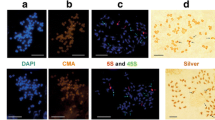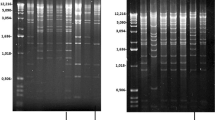Abstract
Sublimons are substoichiometric DNA molecules which are generated by recombinations across short repeats, located in main mitochondrial genome of plants. Since short repeats are believed to recombine irreversibly and to be usually inactive, it is unknown how substoichiometric sequences are maintained. Occasionally, sublimons are amplified during substoichiometric shifting (SSS) and take the role of the main genome. Using the Phaseolus vulgaris system, we have addressed the questions concerning accumulation of sublimons, the role of recombination in their maintenance and selective amplification during SSS. We found that sublimons accompanied by parental recombination sequences were maintained by constant recombination across a short 314-bp repeat. The abundance of these sublimons was three orders of magnitude higher than accumulation of those which could not be maintained by recombination because their parental forms were absent from the main genome. As expected for active recombination, two recombination-derived sublimons were equimolar and so were their parental forms. One parental and one substoichiometric form shared the A/C polymorphism indicating their frequent inter-conversion. Only the C variant of the sublimon was amplified during substoichiometric shift implying strong selection of DNA molecules operating during SSS.



Similar content being viewed by others
References
Abad AR, Mehrtens BJ, Mackenzie SA (1995) Specific expression in reproductive tissues and fate of a mitochondrial sterility-associated protein in cytoplasmic male-sterile bean. Plant Cell 7:271–285
Aksyonova E, Sinyavskaya M, Danilenko N et al (2005) Heteroplasmy and paternally oriented shift of the organellar DNA composition in barley–wheat hybrids during backcrosses with wheat parents. Genome 48:761–769
Albert B, Lelandais C, Pla M et al (2003) Amplification of Nicotiana sylvestris mitochondrial subgenomes is under nuclear control and is associated with phenotypic changes. Genetica 117:17–25. doi:10.1023/A:1022356330794
Arrieta-Montiel M, Lyznik A, Woloszynska M et al (2001) Tracing evolutionary and developmental implications of mitochondrial stoichiometric shifting in the common bean. Genetics 158:851–864
Barr CM, Neimsn M, Taylor DR (2005) Inheritance and recombination of mitochondrial genomes in plants, fungi and animals. New Phytol 168:39–50. doi:10.1111/j.1469-8137.2005.01492.x
Bellaoui M, Martin-Canadell A, Pelletier G, Budar F (1998) Low-copy-number molecules are produced by recombination, actively maintained and can be amplified in the mitochondrial genome of Brassicaceae: relationship to reversion of the male sterile phenotype in some cybrids. Mol Gen Genet 257:177–185. doi:10.1007/s004380050637
Braasch DA, Corey DR (2000) Locked nucleic acid (LNA): fine tuning the recognition of DNA and RNA. Chem Biol 55:1–7
Garcia-Diaz A, Oya R, Sanchez A, Luque F (2003) Effect of prolonged vegetative reproduction of olive tree cultivars (Olea europaea L.) in mitochondrial homoplasmy and heteroplasmy. Genome 46:377–381. doi:10.1139/g03-017
Hattori N, Kitagawa K, Takumi S, Nakamura C (2002) Mitochondrial DNA heteroplasmy in wheat, Aegilops and their nucleus-cytoplasm hybrids. Genetics 160:1619–1630
He S, Abad AR, Gelvin SB, Mackenzie SA (1996) A cytoplasmic male sterility-associated mitochondrial protein causes pollen disruption in transgenic tobacco. Proc Natl Acad Sci USA 93:11763–11768. doi:10.1073/pnas.93.21.11763
Janska H, Mackenzie SA (1993) Unusual mitochondrial genome organization in cytoplasmic male sterile common bean and the nature of cytoplasmic reversion to fertility. Genetics 135:869–879
Janska H, Sarria R, Woloszynska M et al (1998) Stoichiometric shifts in the common bean mitochondrial genome leading to male sterility and spontaneous reversion to fertility. Plant Cell 10:1163–1180
Kanazawa A, Tsutsumi N, Hirai A (1994) Reversible changes in the composition of the population of mtDNAs during dedifferentiation and regeneration in tobacco. Genetics 138:865–870
Kitagawa K, Takumi S, Nakamura C (2002) Evidence of paternal transmission of mitochondrial DNA in a nucleus–cytoplasm hybrid of timopheevi wheat. Genes Genet Syst 77:243–250. doi:10.1266/ggs.77.243
Kmiec B, Woloszynska M, Janska H (2006) Heteroplasmy as a common state of mitochondrial genetic information in plants and animals. Curr Genet 50:149–159. doi:10.1007/s00294-006-0082-1
Koshkin AA, Singh SK, Nielsen P et al (1998) LNA (locked nucleic acid): synthesis of the adenine, cytosine, guanine, 5-methylcytosine, thymine, and uracil bicyclonucleoside monomers, oligomerisation, and unprecedented nucleic acid recognition. Tetrahedron 54:3607–3630. doi:10.1016/S0040-4020(98)00094-5
Kubo T, Newton KJ (2008) Angiosperm mitochondrial genomes and mutations. Mitochondrion 8:5–14. doi:10.1016/j.mito.2007.10.006
Laser B, Mohr S, Odenbach W et al (1997) Parental and novel copies of the mitochondrial orf25 gene in the hybrid crop-plant triticale: predominant transcriptional expression of the maternal gene copy. Curr Genet 32:337–347. doi:10.1007/s002940050286
Lilly JW, Bartoszewski G, Malepszy S, Havey MJ (2001) A major deletion in the cucumber mitochondrial genome sorts with the MSC phenotype. Curr Genet 40:144–151. doi:10.1007/s002940100238
Mackenzie SA (1991) Identification of a sterility-inducing cytoplasm in a fertile accession line of Pheseolus vulgaris L. Genetics 127:411–416
Mackenzie SA, Pring DR, Bassett MJ, Chase CD (1988) Mitochondrial DNA rearrangement associated with fertility restoration and cytoplasmic reversion to fertility in cytoplasmic male sterile Phaseolus vulgaris L. Proc Natl Acad Sci USA 85:2714–2717. doi:10.1073/pnas.85.8.2714
Manchekar M, Scissum-Gun K, Song D et al (2006) DNA recombination activity in soybean mitochondria. J Mol Biol 356:288–299. doi:10.1016/j.jmb.2005.11.070
Martinez-Zapater JM, Gil P, Capel J, Somerville CR (1992) Mutations at the Arabidopsis CHM locus promote rearrangements of the mitochondrial genome. Plant Cell 4:889–899
Sakamoto W, Kondo H, Murata M, Motoyoshi F (1996) Altered mitochondrial gene expression in a maternal distorted leaf mutant of Arabidopsis induced by chloroplast mutator. Plant Cell 8:1377–1390
Senescau A, Berry A, Benoit-Vical F et al (2005) Use of a locked-nucleic-acid oligomer in the clamped-probe assay for detection of a minority Pfcrt K76T mutant population of Plasmodium falciparum. J Clin Microbiol 43:3304–3308. doi:10.1128/JCM.43.7.3304-3308.2005
Shedge V, Arrieta-Montiel M, Christensen AC, Mackenzie SA (2007) Plant mitochondrial recombination surveillance requires unusual RecA and MutS homologs. Plant Cell 19:1251–1264. doi:10.1105/tpc.106.048355
Small I, Suffolk R, Leaver CJ (1989) Evolution of plant mitochondrial genomes via substoichiometric intermediates. Cell 58:67–76. doi:10.1016/0092-8674(89)90403-0
Welch ME, Darnell MZ, McCauley DE (2006) Variable populations within variable populations: quantifying mitochondrial heteroplasmy in natural populations of the gynodioecious plant Silene vulgaris. Genetics 174:829–837. doi:10.1534/genetics.106.059246
Woloszynska M, Kieleczawa J, Ornatowska M et al (2001) The origin and maintenance of the small repeat in the bean mitochondrial genome. Mol Gen Genet 265:865–872
Woloszynska M, Kmiec B, Mackiewicz P, Janska H (2006) Copy number of bean mitochondrial genes estimated by real-time PCR does not correlate with the number of gene loci and transcript levels. Plant Mol Biol 61:1–12. doi:10.1007/s11103-005-5773-3
Yamato KT, Newton K (1999) Heteroplasmy and homoplasmy for maize mitochondrial mutants: a rare homoplasmic nad4 deletion mutant plant. J Hered 90:369–373. doi:10.1093/jhered/90.3.369
Zaegel V, Guermann B, LeRet M et al (2006) The plant-specific ssDNA binding protein OSB1 is involved in the stoichiometric transmission of mitochondrial DNA in Arabidopsis. Plant Cell 18:3548–3563. doi:10.1105/tpc.106.042028
Acknowledgments
This work was supported by grant No. N301 015 32/0938 from the Polish Ministry of Science and Higher Education.
Author information
Authors and Affiliations
Corresponding author
Rights and permissions
About this article
Cite this article
Woloszynska, M., Trojanowski, D. Counting mtDNA molecules in Phaseolus vulgaris: sublimons are constantly produced by recombination via short repeats and undergo rigorous selection during substoichiometric shifting. Plant Mol Biol 70, 511–521 (2009). https://doi.org/10.1007/s11103-009-9488-8
Received:
Accepted:
Published:
Issue Date:
DOI: https://doi.org/10.1007/s11103-009-9488-8




